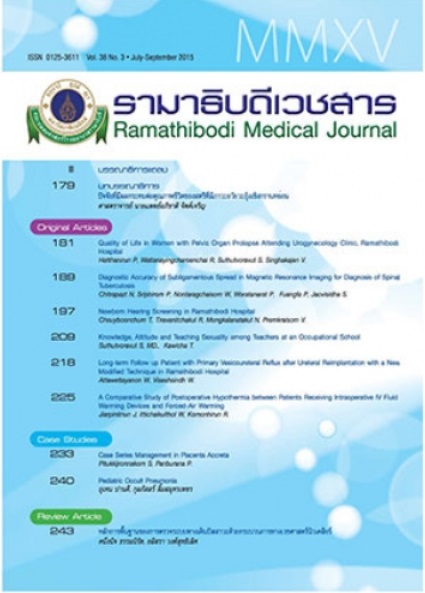Diagnostic Accuracy of Subligamentous Spread in Magnetic Resonance Imaging
Keywords:
Spinal tuberculosis, Pott’s disease, Subligamentous spreadAbstract
Objective: To evaluate the diagnostic value of subligamentous spread in the spinal tuberculosis.
Methods: Retrospective review of spinal magnetic resonance images was performed to evaluate the subligamentous spreading in 84 patients. The differentiation of subligamentous spreading in group of spinal tuberculosis and spinal metastasis were analyzed.
Result: There was statistically significant difference (p-value < 0.05) by univariate and multivariate analyses in parameters of location of the spinal involvement and maximum thickness of subligamentous spread between the groups of spinal TB and spinal metastasis. The presence of subligamentous spread and number of level involved had statistically significant difference by univariate analysis. Each millimeter of increased maximum thickness of subligamentous spread increased the probability of spinal TB about 1.36 times. The sensitivity, specificity, accuracy, positive predictive value and negative predictive value are 78.38%, 59.57%, 67.86%, 60.42%, and 77.78%, respectively.
Conclusions: There was statistically significant difference in the presence of subligamentous spread, number of level involved, maximum thickness, and location of spinal involvement between the groups of spinal tuberculosis and spinal metastasis. Increased maximum thickness of subligamentous spread increases the probability of spinal tuberculosis.
References
World Health Organization. Global tuberculosis report 2014. France; 2004.
Turgut M. Spinal tuberculosis (Pott's disease): its clinical presentation, surgical management, and outcome. A survey study on 694 patients. Neurosurg Rev. 2001;24(1):8-13.
Jain AK. Tuberculosis of the spine: a fresh look at an old disease. J Bone Joint Surg Br. 2010;92(7):905-13. doi:10.1302/0301-620X.92B7.24668.
Garg RK, Somvanshi DS. Spinal tuberculosis: a review. J Spinal Cord Med. 2011;34(5):440-54. doi:10.1179/2045772311Y.0000000023.
Ansari S, Amanullah MF, Ahmad K, Rauniyar RK. Pott's spine: diagnostic imaging modalities and technology advancements. N Am J Med Sci. 2013;5(7):404-11. doi:10.4103/1947-2714.115775.
Patkar D, Narang J, Yanamandala R, Lawande M, Shah GV. Central nervous system tuberculosis: pathophysiology and imaging findings. Neuroimaging Clin N Am. 2012 Nov;22(4):677-705. doi:10.1016/j.nic.2012.05.006.
Jain AK, Sreenivasan R, Saini NS, Kumar S, Jain S, Dhammi IK. Magnetic resonance evaluation of tubercular lesion in spine. Int Orthop. 2012;36(2):261-9. doi:10.1007/s00264-011-1380-x.
Andronikou S, Jadwat S, Douis H. Patterns of disease on MRI in 53 children with tuberculous spondylitis and the role of gadolinium. Pediatr Radiol. 2002;32(11):798-805.
Newman JS, Weissman BN, Angevine PD, et al. ACR Appropriateness Criteria®: Chronic Neck Pain. American College of Radiology [Internet]. 2011 [cited 2015 Apr 25]. https://acsearch.acr.org/docs/69426/Narrative/
Davis PC, Wippold FJ 2nd, Brunberg JA, et al. ACR Appropriateness Criteria®: Low Back Pain. American College of Radiology [Internet]. 2011 [cited 2015 Apr 25]. https://acsearch.acr.org/docs/69483/Narrative/
Jeong SJ, Choi SW, Youm JY, Kim HW, Ha HG, Yi JS. Microbiology and epidemiology of infectious spinal disease. J Korean Neurosurg Soc. 2014;56(1):21-7. doi:10.3340/jkns.2014.56.1.21.
Go JL, Rothman S, Prosper A, Silbergleit R, Lerner A. Spine infections. Neuroimaging Clin N Am. 2012;22(4):755-72. doi:10.1016/j.nic.2012.06.002.
Chang MC, Wu HT, Lee CH, Liu CL, Chen TH. Tuberculous spondylitis and pyogenic spondylitis: comparative magnetic resonance imaging features. Spine. 2006;31(7):782-8.
Danchaivijitr N, Temram S, Thepmongkhol K, Chiewvit P. Diagnostic accuracy of MR imaging in tuberculous spondylitis. J Med Assoc Thai. 2007;90(8):1581-9.
Downloads
How to Cite
Issue
Section
License
Copyright (c) 2015 By the authors. Licensee RMJ, Faculty of Medicine Ramathibodi Hospital, Mahidol University, Bangkok, Thailand

This work is licensed under a Creative Commons Attribution-NonCommercial-NoDerivatives 4.0 International License.













